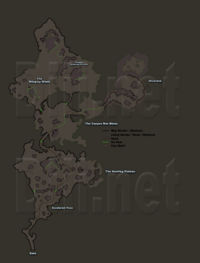Levels
Levels are the discrete areas your hero explores as he or she works their way through the land of Sanctuary, in Diablo III. A level is demarcated by being named on the mini map while clearing it. Known levels from the WWI 2008 movie include the Forgotten Tombs and the Leoric Highlands. Known levels from the BlizzCon 2009 demo include Alcarnus and Stinging Winds.
- Here you can find a full list of Diablo III levels.
Variety
Though fans have thus far seen only a few levels, Blizzard promises that there will be lots of them in the final game; as many or more than there were in Diablo II, and with a wide variety of appearances and styles. Bashiok commented on this in July 2009.[1]
- I think there’s a nice juxtaposition between the larger more epic dungeons and the others that may be less epic but have very specific tones and themes associated with them. When you step inside one of the more epic dungeons, like the Tristram cathedral (and considering its past, shouldn’t it be epic?) you immediately know you’re somewhere important. Somewhere that looks and feels magical in its presentation and lighting, as opposed to, say… a cave.
- Still cool! Caves are still awesome, but you probably don’t want magical purple and green lighting in a cave, it’s probably going to have a much different and subdued feel. If it’s a natural cave it may have light streaming in from cracks above, or if it’s a mine it might have lighting from lanterns. Much earthier and natural. Then you walk into some ancient tomb of a powerful wizard, oh crap, this place clearly has something else going on. The lighting is a bit unnatural, maybe some sickly greenish hues to set a theme and mood.
- That type of theming adds a lot to keeping the scenery changing and interesting. If you’re just fighting demons against a grey or brown backdrop for hours and hours, days and days, maybe years and years… it gets boring. Interesting, themed, and contrasting scenery all help ensure visual longevity.
- I think before too long we’ll have shown a nice cross section of the dungeon types and looks. It’s been too long staring at the one dungeon. Each one has a very unique look and feel, so it’s really cool going in to each one and having a total change of scenery. It’s all very exciting and we’re all looking forward to sharing it with you and seeing the fan reactions just as soon as it’s ready.
Randomized vs. Pre-designed
One big change in Diablo 3 vs. Diablo 2 is the fact that most surface areas in Diablo 3 will be non-random in their general layout. There will still be randomized elements on the surface; but the general shapes of the levels will not vary from game to game. This concept was explained by Diablo 3 Community Manager Bashiok in July 2009. [2]
- Randomized levels can indeed create a very generic feeling if not done well. We’re working really hard to ensure that doesn’t happen though. It’s actually one of the reasons why our exterior layouts aren’t randomized. It’s extremely difficult to have wide open areas be randomized as well as interesting. Instead we have static exterior zones where the roads, towns, and edges are always in the same place. To keep some bits of random in there though we have a bunch of small, medium, and large pieces cut out of them. In those cut out pieces the game can then place the randomized “adventure” sets. They could be artistic in nature (a fountain, an abandoned cart), they could spawn extra enemies, or they could spawn quests.
- Our interiors are randomized, but we do some things differently that help make them more interesting. I think we accomplish this mostly by using our interior jigsaw pieces more intelligently, building more and different types of jigsaw pieces, and also because our artists are amazing. I don’t think anywhere in Diablo III are you going to think “This place is not visually interesting”. The types of interior pieces do make an enormous difference, and I think we’re pretty good at it now. In Diablo II for example you pretty much had a few standard square set pieces, and then a bunch of hallways. We still have those in Diablo III but we’re mixing it up a lot more with more intricate and interesting ‘showcase’ pieces that make it seem like they’re not even randomized levels.
Players who were able to explore the same areas in multiple games, especially the desert surface areas of Act 2, found the outlines repeating every game, but didn't mind the approach. The borders of levels were always the same, but they were much more interesting in their art design and layout than the largely square, right-angles at the edges of outdoor levels in Diablo 2. There were also a number of chests placed around the outer borders of the Diablo 3 surface levels, rewarding players who explored the entire area.
Contained within the surface areas were numerous sections where semi-random objects appeared; in different games a player might find empty space, a small, ruined town, an NPC with a quest, or a big pack of boss monsters, and this kept the exploration and exploration fun. That said, it remains to be seen how well this non-randomization will hold up long term, once players have raced through the same levels dozens or hundreds of times.
| Diablo III Levels [e] | |||
|---|---|---|---|
| Act I: Khanduras | Act II: Borderlands
|
Act II continued
|
Act III: Barbarian Lands |
| This article is a stub because it lacks depth or is unfinished. Help by expanding it. |
